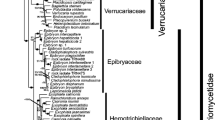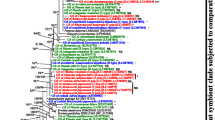Abstract
Bacterial symbionts play a critical role in the physiology, ecology and evolution of a diverse range of insects. Such symbionts with unknown roles in the ecology and evolution of their hosts have been reported from archaeococcoid scale insects of family Coelostomidiidae. We examine in detail the bacterial community associated with the remaining species of this family, and calculate the cophylogenetic relationship between the hosts and their symbionts. The 28S ribosomal RNA (rRNA) and mitochondrial cytochrome oxidase I genes were used to reconstruct the host phylogeny while the 16S rRNA gene was used for the bacterial phylogeny. Three well-supported clades were detected within the phylogeny of the monophyletic family Coelostomidiidae. Besides the known symbionts, a novel Sodalis-like symbiont was detected from three of the species. The primary bacteriome inhabiting B-symbiont (Bacteroidetes; ‘Candidatus Hoataupuhia coelostomidicola’) was widespread across the host family. Cophylogenetic comparison using Jungles-based reconciliation analysis and ParaFit statistical test revealed a strongly congruent phylogeny of this symbiont with the host family, with no host-switches and few losses and duplications. A similar pattern was observed across a relatively unrelated neococcoid family that exhibits a different physiology and symbiont community, besides a related Bacteroidetes symbiont. We reconfirm that the B-symbiont is a primary symbiont, owing to its strongly congruent evolution with the host and its bacteriome-inhabiting nature. Our analysis affirms recent suggestions that the Bacteroidetes-affiliated symbionts may have driven the hyper-diversification of scale insects worldwide.





Similar content being viewed by others
References
Alfano JR, Collmer A (1996) Bacterial pathogens in plants: life up against the wall. Plant Cell 8(10):1683–1698
Ball S, Armstrong K (2007) Using DNA barcodes to investigate the taxonomy of the New Zealand sooty beech scale insect. DOC research & development series, vol 287. Bio-Protection Research Centre, New Zealand
Bromham L, Penny D, Rambaut A, Hendy MD (2000) The power of relative rates tests depends on the data. J Mol Evol 50(3):296–301
Buckley TR (2002) Model misspecification and probabilistic tests of topology: evidence from empirical data sets. Syst Biol 51(3):509–523. doi:10.1080/10635150290069922
Charleston M (1998) Jungles: a new solution to the host/parasite phylogeny reconciliation problem. Math Biosci 149(2):191–223
Charleston M, Page R (2002) TreeMap. v. 2.0. 2. Software distributed by authors
Conord C, Despres L, Vallier A, Balmand S, Miquel C, Zundel S, Lemperiere G, Heddi A (2008) Long-term evolutionary stability of bacterial endosymbiosis in Curculionoidea: additional evidence of symbiont replacement in the Dryophthoridae family. Mol Biol Evol 25(5):859–868. doi:10.1093/molbev/msn027
Dale C, Maudlin I (1999) Sodalis gen. nov. and Sodalis glossinidius sp. nov., a microaerophilic secondary endosymbiont of the tsetse fly Glossina morsitans morsitans. Int J Syst Bacteriol 49(1):267–275
Degnan JH, Rosenberg NA (2009) Gene tree discordance, phylogenetic inference and the multispecies coalescent. Trends Ecol Evol 24(6):332–340
Dhami MK, Turner AP, Deines P, Beggs JR, Taylor MW (2012) Ultrastructural and molecular characterization of a bacterial symbiosis in the ecologically important scale insect family Coelostomidiidae. FEMS Microbiol Ecol 81(3):537–546. doi:10.1111/j.1574-6941.2012.01378.x
Dowton M, Austin AD (1998) Phylogenetic relationships among the microgastroid wasps (Hymenoptera: Braconidae): combined analysis of 16S and 28S rDNA genes and morphological data. Mol Phylogen Evol 10(3):354–366
Drummond A, Rambaut A (2007) BEAST: Bayesian evolutionary analysis by sampling trees. BMC Evol Biol 7(1):214. doi:10.1186/1471-2148-7-214
Drummond AJ, Ashton B, Buxton S, Cheung M, Cooper A, Duran C, Field M, Heled J, Kearse M, Markowitz S, Moir R, Stones-Havas S, Sturrock S, Thierer T, Wilson A (2011) Geneious v 5.6. Available from http://www.geneious.com
Foldi I (2009) Archaeococcoid scale insects (Hemiptera: Coccoidea) from the tropical high mountains of the Andean Cordillera, South America. Zootaxa 2300:1–38
Fourment M, Gibbs MJ (2006) PATRISTIC: a program for calculating patristic distances and graphically comparing the components of genetic change. BMC Evol Biol 6 (1). doi:10.1186/1471-2148-6-1
Gardner-Gee R, Beggs JR (2009) Distribution and abundance of endemic coelostomidiid scale insects (Hemiptera: Coelostomidiidae) in Auckland forests, New Zealand. N Z J Ecol 33(2):138–146
Gruwell ME, Von Dohlen CD, Patch K, Normark BB (2005) Preliminary PCR survey of bacteria associated with scale insects (Hemiptera: Coccoidea). Proceedings of the Tenth International Symposium on Scale Insect Studies, Adana, Turkey, 19–23 April 2004:49–57
Gruwell ME, Morse GE, Normark BB (2007) Phylogenetic congruence of armored scale insects (Hemiptera: Diaspididae) and their primary endosymbionts from the phylum Bacteroidetes. Mol Phylogen Evol 44(1):267–280
Gruwell ME, Hardy NB, Gullan PJ, Dittmar K (2010) Evolutionary relationships among primary endosymbionts of the mealybug subfamily Phenacoccinae (Hemiptera: Coccoidea: Pseudococcidae). Appl Environ Microbiol 76(22):7521–7525
Gruwell ME, Flarhety M, Dittmar K (2012) Distribution of the primary endosymbiont (Candidatus Uzinura diaspidicola) within host insects from the scale insect family Diaspididae. Insects 3(1):262–269
Gullan PJ, Cook LG (2007) Phylogeny and higher classification of the scale insects (Hemiptera: Sternorrhyncha: Coccoidea). Zootaxa 1668:413–425
Heled J, Drummond AJ (2010) Bayesian inference of species trees from multilocus data. Mol Biol Evol 27(3):570–580
Huber T, Faulkner G, Hugenholtz P (2004) Bellerophon: a program to detect chimeric sequences in multiple sequence alignments. Bioinformatics 20(14):2317–2319. doi:10.1093/bioinformatics/bth226
Juretschko S, Timmermann G, Schmid M, Schleifer K-H, Pommerening-Röser A, Koops H-P, Wagner M (1998) Combined molecular and conventional analyses of nitrifying bacterium diversity in activated sludge: Nitrosococcus mobilis and Nitrospira-like bacteria as dominant populations. Appl Environ Microbiol 64(8):3042–3051
Kaiwa N, Hosokawa T, Kikuchi Y, Nikoh N, Meng XY, Kimura N, Ito M, Fukatsu T (2010) Primary gut symbiont and secondary, Sodalis-allied symbiont of the scutellerid stinkbug Cantao ocellatus. Appl Environ Microbiol 76(11):3486–3494. doi:10.1128/aem.00421-10
Kane MD, Poulsen LK, Stahl DA (1993) Monitoring the enrichment and isolation of sulfate-reducing bacteria by using oligonucleotide hybridization probes designed from environmentally derived 16S rRNA sequences. Appl Environ Microbiol 59(3):682–686
Katoh K, Misawa K, Kuma K, Miyata T (2002) MAFFT: a novel method for rapid multiple sequence alignment based on fast Fourier transform. Nucleic Acids Res 30(14):3059–3066
Legendre P, Anderson M (1998) Program distpcoa. Département de Sciences Biologiques, Université de Montréal, Montreal
Legendre P, Desdevises Y, Bazin E (2002) A statistical test for host–parasite coevolution. Syst Biol 51(2):217–234
Maidak BL, Cole JR, Lilburn TG, Parker CT Jr, Saxman PR, Farris RJ, Garrity GM, Olsen GJ, Schmidt TM, Tiedje JM (2001) The RDP-II (ribosomal database project). Nucleic Acids Res 29(1):173–174
Matsuura Y, Koga R, Nikoh N, Meng XY, Hanada S, Fukatsu T (2009) Huge symbiotic organs in giant scale insects of the genus Drosicha (Coccoidea: Monophlebidae) harbor flavobacterial and enterobacterial endosymbionts. Zool Sci 26(7):448–456
McClure MS (1990) Impact on host plants. In: Rosen D (ed) Armoured scale insects: their biology, natural enemies and control, vol 4B. Elsevier, Amsterdam, pp 289–291
McCutcheon JP, Moran NA (2007) Parallel genomic evolution and metabolic interdependence in an ancient symbiosis. Proc Natl Acad Sci U S A 104(49):19392–19397
McCutcheon JP, Moran NA (2012) Extreme genome reduction in symbiotic bacteria. Nat Rev Microbiol 10(1):13–26
Morales CF (1990) The taxonomic revision of the New Zealand Margarodidae with studies of the life history and biology of two species. Unpublished Ph.D. Thesis, Imperial College of Science and Technology, University of London, United Kingdom
Morales CF (1991) Fauna of New Zealand: Margarodidae (Insecta: Hemiptera), vol 21. DSIR Plant Protection, Auckland
Moran NA, Tran P, Gerardo NM (2005) Symbiosis and insect diversification: an ancient symbiont of sap-feeding insects from the bacterial phylum Bacteroidetes. Appl Environ Microbiol 71(12):8802–8810
Ovadia Y, Fielder D, Conow C, Libeskind-Hadas R (2011) The cophylogeny reconstruction problem is NP-complete. J Comput Biol 18(1):59–65
Page RDM (2003) Tangled trees: phylogeny, cospeciation, and coevolution. University of Chicago Press, Chicago
Page RDM, Charleston MA (1997) Reconciled trees and incongruent gene and species trees. Math Hierarchies Biol 37:57–70
Park D-S, Suh S-J, Oh H-W, Hebert PDN (2010) Recovery of the mitochondrial COI barcode region in diverse Hexapoda through tRNA-based primers. BMC Genomics 11. doi:10.1186/1471-2164-11-423
Pollard DA, Iyer VN, Moses AM, Eisen MB (2006) Widespread discordance of gene trees with species tree in Drosophila: evidence for incomplete lineage sorting. PLoS Genet 2(10):e173. doi:10.1371/journal.pgen.0020173
Posada D (2009) Selection of models of DNA evolution with jModelTest. Methods Mol Biol 537:93–112
Pruesse E, Quast C, Knittel K, Fuchs BM, Ludwig W, Peplies J, Glöckner FO (2007) SILVA: a comprehensive online resource for quality checked and aligned ribosomal RNA sequence data compatible with ARB. Nucleic Acids Res 35(21):7188–7196
Rambaut A (2007) FigTree, a graphical viewer of phylogenetic trees. Available from http://tree.bio.ed.ac.uk/software/figtree. University of Edinburg, UK
Rosenblueth M, Sayavedra L, Sámano-Sánchez H, Roth A, Martínez-Romero E (2012) Evolutionary relationships of flavobacterial and enterobacterial endosymbionts with their scale insect hosts (Hemiptera: Coccoidea). J Evol Biol 25(11):2357–2368. doi:10.1111/j.1420-9101.2012.02611.x
Sabree ZL, Huang CY, Okusu A, Moran NA, Normark BB (2013) The nutrient supplying capabilities of Uzinura, an endosymbiont of armoured scale insects. Environ Microbiol. doi:10.1111/1462-2920.12058
Shimodaira H, Hasegawa M (1999) Multiple comparisons of log-likelihoods with applications to phylogenetic inference. Mol Biol Evol 16:1114–1116
Smit E, Leeflang P, Wernars K (1997) Detection of shifts in microbial community structure and diversity in soil caused by copper contamination using amplified ribosomal DNA restriction analysis. FEMS Microbiol Ecol 23(3):249–261
Stouthamer R, Breeuwer JAJ, Hurst GDD (1999) Wolbachia pipientis: microbial manipulator of arthropod reproduction. Annu Rev Microbiol 53:71–102
Swofford DL (2003) PAUP*: Phylogenetic Analysis Using Parsimony (* and Other Methods), version 4.0 b10. Sinauer Associates, Sunderland
Tajima F (1993) Simple methods for testing the molecular evolutionary clock hypothesis. Genetics 135(2):599–607
Takiya DM, Tran PL, Dietrich CH, Moran NA (2006) Co-cladogenesis spanning three phyla: leafhoppers (Insecta: Hemiptera: Cicadellidae) and their dual bacterial symbionts. Mol Ecol 15(13):4175–4191
Tamura K, Peterson D, Peterson N, Stecher G, Nei M, Kumar S (2011) MEGA5: molecular evolutionary genetics analysis using maximum likelihood, evolutionary distance, and maximum parsimony methods. Mol Biol Evol 28(10):2731–2739
Taylor MW, Schupp PJ, Dahllof I, Kjelleberg S, Steinberg PD (2004) Host specificity in marine sponge associated bacteria, and potential implications for marine microbial diversity. Environ Microbiol 6(2):121–130
Toenshoff ER, Gruber D, Horn M (2012) Co-evolution and symbiont replacement shaped the symbiosis between adelgids (Hemiptera: Adelgidae) and their bacterial symbionts. Environ Microbiol 14(5):1284–1295. doi:10.1111/j.1462-2920.2012.02712.x
Wernegreen JJ (2002) Genome evolution in bacterial endosymbionts of insects. Nat Rev Genet 3(11):850–861
Whiting MF, Carpenter JC, Wheeler QD, Wheeler WC (1997) The Stresiptera problem: phylogeny of the holometabolous insect orders inferred from 18S and 28S ribosomal DNA sequences and morphology. Syst Biol:1–68
Wren BW (2002) Deciphering tsetse’s secret partner. Nat Genet 32(3):335–336
Acknowledgments
We would like to thank Sandra Anderson, Robert Brown, Auckland Regional Council and Department of Conservation, New Zealand for facilitating scale insect collections. We are grateful to Dr Bevan Weir for valuable advice on the manuscript and Te Haumihiata from the Maori Language Commission, New Zealand for help with the naming of the B-symbiont. Funding was provided by a University of Auckland International Doctoral Scholarship to M.K.D. and a University of Auckland Faculty Research Development Fund grant (9841 3624443) to J.R.B and M.W.T.
Data Accessibility
DNA sequences: GenBank accessions JX513961 - JX514003, KC447385 - KC447453 and KF697119.
Specimen vouchers: Voucher slides of specimens are accessioned in the New Zealand Arthropod Collection slide collection (institute code: NZAC), Landcare Research, Auckland, New Zealand. Accession numbers are in Table 1.
Author information
Authors and Affiliations
Corresponding author
Electronic supplementary material
Below is the link to the electronic supplementary material.
ESM 1
(DOCX 47.5 kb)
Rights and permissions
About this article
Cite this article
Dhami, M.K., Buckley, T.R., Beggs, J.R. et al. Primary symbiont of the ancient scale insect family Coelostomidiidae exhibits strict cophylogenetic patterns. Symbiosis 61, 77–91 (2013). https://doi.org/10.1007/s13199-013-0257-8
Received:
Accepted:
Published:
Issue Date:
DOI: https://doi.org/10.1007/s13199-013-0257-8




